 Schrödinger’s cat, simultaneously alive and deceased, persists as the quintessential analogy for quantum indeterminacy. (AI generated image/DALLE)
Schrödinger’s cat, simultaneously alive and deceased, persists as the quintessential analogy for quantum indeterminacy. (AI generated image/DALLE)
The transistors enabling your smartphone, the MRI machines detecting tumors and blockages in the coronary arteries, as well as the atomic clocks used in GPS systems aiding navigation for vehicles and aircraft—all these technologies operate based on principles that have long unsettled some of the brightest intellects. The outcomes predicted by this field were so peculiar that Albert Einstein, renowned for his appreciation of scientific coherence, stated, "God does not play dice with the universe."
That science is quantum mechanics —the structure that rules the cosmos at its tiniest levels.
At the core of quantum mechanics is a profound change in our comprehension: Both matter and light exhibit characteristics of being particles as well as waves when scrutinized at an infinitesimal scale. Furthermore, these entities reside in multiple potential conditions simultaneously up until the point they get measured or observed. This can be likened to stating that reality becomes concrete solely upon observation. Intriguing, isn’t it? Continue reading for insight.
A radiance that didn’t belong
As the 20th century began, classical physics appeared triumphant, accounting for much of what we observed—heat, light, electricity, and movement. However, lurking beneath this success were inconsistencies. Classical physical theories failed to accurately describe events occurring at an atomic and subatomic scale. Notably, experiments with blackbody radiation exposed a significant problem: heated bodies didn’t emit light as expected, particularly at higher frequencies.
To resolve this "ultraviolet catastrophe," Max Planck suggested that energy exists in distinct bundles called quanta. By assuming that every atom either emits or absorbs only complete units of these minuscule energy packets, Planck's equation accurately mirrored the experimental observations. Thus began the era of quantum physics.
Bohr's atom and waves: The concept of particle duality
In the subsequent years, as the Newton-Einstein framework provided insights into the large-scale universe, other researchers focused on elucidating atomic behavior. In 1913, Niels Bohr employed quantized energy levels to clarify why atoms radiate light exclusively at particular wavelengths; he proposed that electrons move around the nucleus in distinct paths and transition from one orbit to another by either taking up or releasing a photon.
Shortly after, Louis de Broglie proposed that matter—including electrons—exhibits wavelike properties too. Subsequent experiments showed that electrons could create interference patterns, even though they were detected individually.
Werner Heisenberg Then demonstrated that it is essentially impossible to simultaneously determine both the exact position of a subatomic particle and its velocity — this being the renowned uncertainty principle. Erwin Schrödinger , conversely, characterized particles as evolving wavefunctions, providing merely the likelihood of where a particle could be located. Thus, evidently, both light and matter employ a dual vocabulary: at times behaving like waves, at others like particles.
Bohr versus Einstein: A Clash of Worldviews
However, this peculiar new theory was not widely accepted by all. Albert Einstein strongly held the belief in an external reality — one that exists separately from observation. Niels Bohr However, they contended that quantum mechanics provides a complete description of reality, despite contradicting classical intuition.
Their renowned debates reached a climax at the 1927 Solvay Conference Where the planet's leading physicists convened to explore the depths of quantum mechanics, Einstein continually presented hypothetical scenarios to challenge these concepts. In response, Bohr skillfully countered each argument with his characteristic patience. This intellectual exchange stands as one of the most significant scientific dialogues of the 20th century.
Schrödinger’s cat: Is it dead or alive?
Two ideas from the unfolding quantum realm particularly unnerved its detractors:
📍superposition, which indicates that a particle can be in several states at once simultaneously until it gets measured, and
📍Entanglement refers to the phenomenon where two connected particles behave synchronously, instantaneously influencing each other’s states regardless of the distance between them.
In 1935, Einstein, along with Boris Podolsky and Nathan Rosen (known as EPR), contended that quantum mechanics failed to fully capture the essence of physical reality. To address this challenge, Schrödinger introduced a well-known hypothetical scenario designed to illustrate how applying principles from the quantum realm to everyday objects leads to illogical outcomes.
In this scenario, a cat is placed inside a box along with a radioactive atom, a Geiger counter to measure radiation, and a vial containing poison. Should the atom decay, the Geiger counter will activate, breaking the vial and resulting in the death of the cat. According to an literal interpretation of quantum superposition, as long as the box remains closed, the cat could theoretically be considered simultaneously alive and deceased.
Schrödinger’s cat remains one of the most iconic representations illustrating the distinction between the classical realm and the quantum domain. The principles governing large-scale phenomena do not hold true for the tiniest constituents of matter, and conversely.
 Within the quantum box: Before being observed, the cat exists in two states—alive and dead—which presents a paradox challenging our understanding of reality.
Within the quantum box: Before being observed, the cat exists in two states—alive and dead—which presents a paradox challenging our understanding of reality.
Bell’s test
The notion that quantum particles follow probabilistic principles disturbed numerous physicists who held onto the belief that nature operates deterministically and objectively. In order to align quantum predictions with their conviction of an inherent, precise reality, proponents suggested hidden-variable theories. These theories posited that particles actually have fixed attributes continuously, yet these traits are controlled by factors beyond our present experimental reach. Since these concealed elements couldn’t be directly observed through experimentation, the behavior of such particles seemed random.
In 1964, John Bell formulated a feasible experiment. It demonstrated that all local hidden-variable theories would have to adhere to specific statistical limits. Bell’s inequalities — Quantum mechanics, however, forecasts distinct deviations from classical expectations. Pioneering experiments starting in the 1970s tested entangled particles and observed precisely these deviations. This conclusion was unavoidable: no explanation based on locality and pre-established conditions could align with quantum predictions. At the quantum scale, nature genuinely exhibits indeterminism and nonlocality.
From crisis to keystone to commonplace
From Planck's initial quantum theory in 1900 to Bell's tests conducted in the '80s, it took many years for society to embrace a universe where particles could also behave like waves, events were inherently random, and far-off particles stayed inexplicably connected. Nonetheless, each experiment validated that despite its peculiarity, quantum mechanics offers us the most precise depiction of reality known today.
After becoming established, quantum mechanics laid the groundwork for many everyday technologies. Semiconductor devices utilize quantum energy levels to manage electrical currents. Lasers operate based on the principle of stimulated photon emissions. Magnetic Resonance Imaging (MRI) machines generate precise images using the quantum spins of atomic nuclei. Additionally, atomic clocks maintain exceptional accuracy by measuring electron oscillations to tell time.
A final reflection
The quantum revolution demonstrates how periods of crisis, marked by experimental findings contradicting conventional theories, can result in paradigm changes that redefine our reality. Through accepting concepts like quantization, wave-particle duality, indeterminacy, and interconnectedness, we have developed innovations beyond what physicists such as Planck, Bohr, and Einstein could envision. With the advent of two groundbreaking technologies—quantum computing and robust quantum communications—we persistently leverage the peculiarities of nature for our benefit. Despite its many contradictions, the cosmos remains our ultimate muse.
Shravan Hanasoge is an astrophysicist at the Tata Institute of Fundamental Research.
For the latest news from across India , Political updates , Explainers , Sports News , Opinion , Entertainment Updates and more Top News , visit Indian Express . Sign up for our prestigious subscription Newsletter Download our App here Android & iOS
